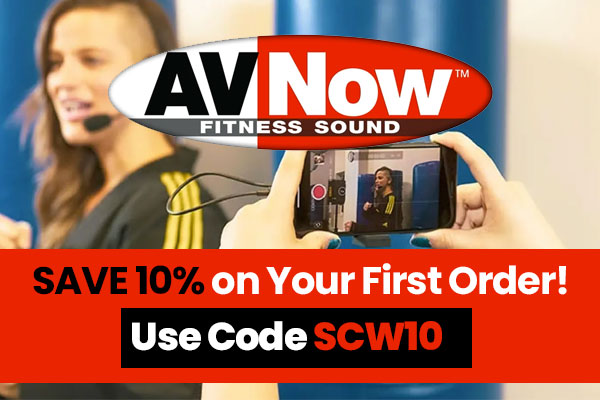
SCW Spotlite: Issue 31
Top 5 Tools Every Virtual Content Creator Needs | Phobias of Training Older Adults | What Trainers Need to Know About Cortisol | Self-Love vs. Self-Care for Fitness Professionals | Pain: Myths & Facts | The COVID Curveball | Blueberry Roll Ups

Top 5 Tools Every Virtual Content Creator Needs
by Lukas Lange
Being a virtual content creator can be pretty challenging. Knowing where and how to find the right virtual content creation tools can be a huge part of that. After all, you got into the fitness business to help people get in shape, not become an Audio/Visual expert!
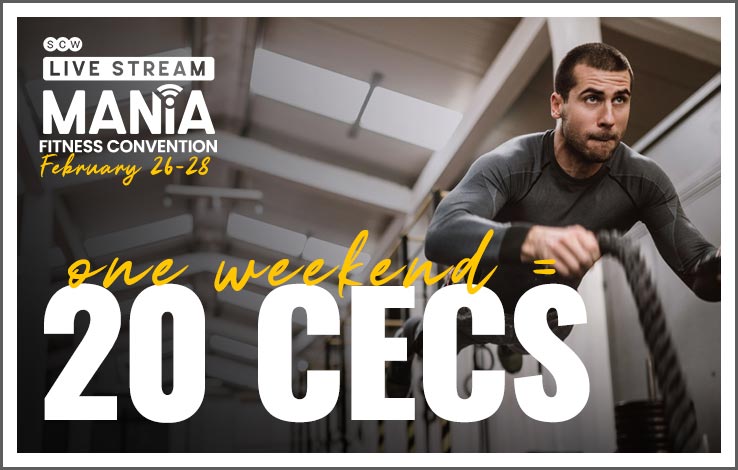 The fact is the world has changed. That’s especially true if you’re used to putting your content out there in person as opposed to Zoom, MindBody, gymGo, UScreen, YouTube or any other virtual content platform for fitness.
The fact is the world has changed. That’s especially true if you’re used to putting your content out there in person as opposed to Zoom, MindBody, gymGo, UScreen, YouTube or any other virtual content platform for fitness.
Well, the good news is that we’re here to make it easy for you. Let’s take a look at the
Top 5 Tools Every Virtual Content Creator Needs.
1. A Mixer
If you want a nice clean sound, a mixer is going to be important. When you are creating virtual content, a muddy audio mix is a huge turn-off to your members.
After all, nothing interrupts the flow of a class more than having your members yelling, “What did you say?” at their screen.
You’re going to want something that can accommodate at least a microphone and speakers.
This is a great USB mixer that can do that and more:
https://www.avnow.com/products/mm8usbfx-mixer-with-cables
2. Advice
Like I said before, you didn’t get into the fitness industry to be an Audio-Visual pro. You did it to help people. Us too.
Go here to answer a few questions about your Audio-Visual needs so we can help.
https://www.avnow.com/pages/virtual-instruction-streaming-solutions-form
Virtual content creation is your thing, but making it look and sound great is ours! Let us help!
3. A Microphone
Now that you’ve got a mixer you’ve got to make sure you have something to plug into it.
There are a lot of choices for microphones. You can go with a fitness wireless headset, a lavalier, or a room mic. That would depend on the type of class you’re running, how much moving around you’re doing and the type and volume of your background music.
You can see a whole bunch of different ideas here:
https://www.avnow.com/collections/wireless-microphones-for-fitness
Now that they can hear you, they need to see something. We know most fitness studios are not created with lighting in mind. Luckily, we can solve that problem.
Lights are an important and sometimes forgotten step in making your overall virtual content look great and professional.
Check out this set up.
https://www.avnow.com/products/lumecube-broadcast-lighting-kit
5. A Camera
That brings us here. What’s the first thing your members are going to see when they log on? You! Remember that first impressions are everything and you need to look professional right off the bat.
The camera in your computer may be OK, but even a little upgrade can make a huge difference in how you’re perceived, and if you’re trying to grow your online and social media business and profile, perception is everything!
If you need help figuring out what camera is right for you, you can go here to answer a few questions about your needs to get some help.
https://www.avnow.com/pages/virtual-instruction-and-streaming-solutions-form-camera-solution
If you just want to skip all that to get a nice, easy solution you can get this one. (It’s more than just a camera, too!)
https://www.avnow.com/products/zoom-q8-hd-video-four-track-audio-recorder
Remember, creating virtual content may be new and challenging for you, but we are here to help. Just in case you need more information, you can meet the representatives from AV Now at the upcoming SCW Live Stream MANIA®, February 26-28 in the FREE Sponsor Showcase. They also have several sessions in the Health and Business Summit throughout the weekend going into details on equipment for virtual training.
Share this Post!

The Phobias of Training Older Adults
by Robert Linkul, MS, CSCS D, NSCA-CPT D, FNSCA
Upon entering the profession, most personal trainers have desires to work with highly competitive and aspiring athletes. They open their schedule and start taking on clients, however, most of their new clients tend to come from the demographic of general health and fitness-based populations (not competitive athletes). A large portion of the general health and fitness demographic is a special population called “older adults.”
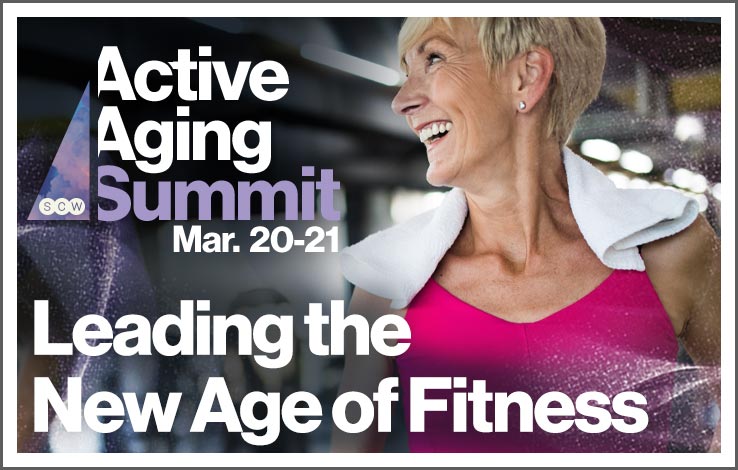 The older adult (50-80 years of age) demographic is in desperate need of professional guidance and direction as they tend to suffer from physical limitations and pain management issues. As it is, most personal trainers do not pursue working with older adults for three reasons.
The older adult (50-80 years of age) demographic is in desperate need of professional guidance and direction as they tend to suffer from physical limitations and pain management issues. As it is, most personal trainers do not pursue working with older adults for three reasons.
1. They Don’t Know How to Assess Their Movement
In an industry full of different assessment strategies, tools and protocols the uneducated and/or inexperienced personal trainer may not possess the skill set to safely assess the older adult. Typical assessments can include exercises like the push-up, the overhead squat or the in-line lunge and when implemented safely and correctly they are perfectly fine for the healthy older adult client to perform. However, for the older adult dealing with one or more physical limitations (sciatica, shoulder impingement, torn meniscus, etc.) or pain management issues, these exercises can be unsafe and/or difficult for the untrained or undertrained older adult to perform.
A large majority of older adults do have at least one physical limitation and that limitation is often the reason for them seeking out the assistance of a fitness professional. It’s the personal trainer’s professional responsibility to “do no harm” with every client in which they have the pleasure of working with and the older adult is no different. If the client indicates the presence of a physical limitation that will not allow them to safely perform movement assessment exercises, then a movement observation assessment may be a more appropriate option.
The Online Movement Observation Form (see image 1) can include rating or scoring a client’s ability to perform basic daily life movements like reaching overhead, sit-to-stand, stepping down and up or getting up and down off the floor. These daily life movements are typically performed by all clients on a regular basis however, the skill to perform these movements may vary from person to person. Based on these basic daily life movements and the client’s ability to perform them efficiently, the personal trainer can build an appropriate program design to address their needs. Eventually, improved efforts in their programing may result in the client being able to perform some or all of the more common exercise-based movement assessments.
2. They are Afraid of Hurting Them
A common misconception is that the older or aging adult is fragile and incapable of performing moderate to advance exercises or highly challenging workouts. This misconception comes from the idea that most people over 50 years of age have some sort of physical limitation that the personal trainer needs to “fix or workaround”. Common limitations could include a lower back, hip, knee or shoulder issue or a physical disease like arthritis, neuropathy or cancer.
Contrary to this belief, the majority of older adults are very capable of training hard and pushing themselves to higher levels even with a physical limitation, however, they may simply need to progress through a training program to reach these levels. A large portion of physical limitations that older adults may have can be improved with the introduction of a basic strength and conditioning program implemented two to three days per week.
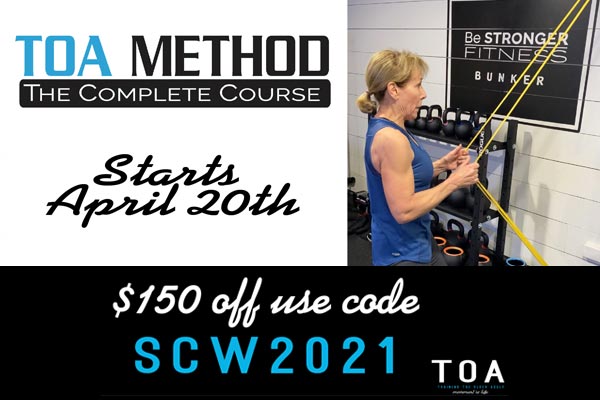 With limited or no experience training clients with physical limitations, some personal trainers will attempt to “workaround” the client’s issue.
With limited or no experience training clients with physical limitations, some personal trainers will attempt to “workaround” the client’s issue.
This creates two issues: first, it does not improve the client’s physical limitation and second, they will improve in all other areas creating a bigger gap between the physical limitation and the rest of the body’s ability to operate. The client’s body will learn to compensate with other musculatures, often leading to more injury. Although improvements have been made, the goal of improving the entire body has become even more difficult as one operating component has been left behind.
To the uneducated and/or inexperienced fitness professionals the aforementioned limitations may be outside their knowledge base. Though the scope of practice for the personal trainer does not include prescribing physical therapy (PT) they are capable and able to implement exercises prescribed by a physical therapist that are specific to the client and their limitations. Clients with a limitation may be asked to go to physical therapy first to help correct their limitation, as this issue is not in an area of expertise for the personal trainer.
In some cases, the limitation can be rehabilitated at the same time as the pursuit of regular health and fitness-based goals. The personal trainer can partner with a physical therapist or coordinate with the client’s current physical therapist as to what exercises they could implement, progress and/or avoid in their daily programming.
Developing a partnership or coordinating with a physical therapist accomplishes a few goals. It provides the personal trainer direction on how to progress their client toward improving their physical limitations correctly. It also provides the trainer the knowledge and experience moving forward with future clients. This does NOT mean that the personal trainer will be capable or able to prescribe physical therapy to future clients. It can provide the trainer with the confidence to use this type of programming again since it was used successfully with a previous client who had the same or similar limitations.
3. They Don’t Know How to Progress Them Appropriately
Many older adults have yet to find their way into a weight room or participate in any form of physical activity, as the baby boomer generation did not have the information on the importance of physical fitness that today’s generations have. Due to this inexperience, the older adult my not have the neuromuscular facilitation (ability to coordinate muscle movement smoothly or efficiently) required to perform even the most basic strength and conditioning movements. This does NOT mean the older adult cannot perform these movements. However, it does mean they will need a safe, progressive and efficient program design with proper cueing to teach them.
Personal trainers can develop a training philosophy that outlines their programming components (push, pull, press, squat, carry, etc.) and the exercise progressions of each. This progression would start with the most-simple (basic) movements like a bridge, strict press, plank and step up to the most complex (advanced) movements like a clean, snatch, get up or box jump. Due to the average older adult’s lack of physical activity and/or strength and conditioning experience, the uneducated and/or inexperienced personal trainer may be intimidated or find it very difficult to work with older adults. However, a training philosophy and exercise progression could drastically help keep the client on track.
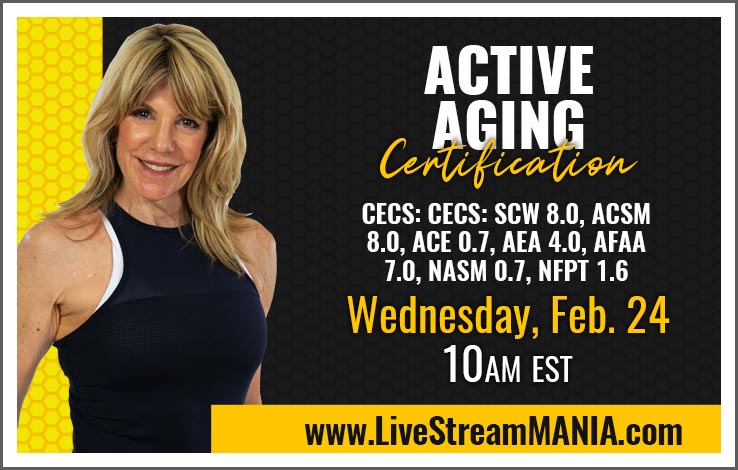 The obstacle of teaching from such a basic level provides two valuable opportunities for the personal trainer. First, it provides a wonderful learning experience to truly have a positive effect on a client’s life. Assisting and helping them improve their ability to move more efficiently, safely and athletically can greatly improve the client’s quality of living. For those suffering from major physical limitations, disease or pain management, this achievement should not be taken lightly as this can be a life-changing experience for some clients. Second, it allows the personal trainer to work on their ability to progress and teach their programming. This is an opportunity to practice and work toward mastering the skills needed to work with individuals of all levels. Those who struggle to perform even the most-simple movements are the ones who need the personal trainer’s assistance, guidance and direction the most.
The obstacle of teaching from such a basic level provides two valuable opportunities for the personal trainer. First, it provides a wonderful learning experience to truly have a positive effect on a client’s life. Assisting and helping them improve their ability to move more efficiently, safely and athletically can greatly improve the client’s quality of living. For those suffering from major physical limitations, disease or pain management, this achievement should not be taken lightly as this can be a life-changing experience for some clients. Second, it allows the personal trainer to work on their ability to progress and teach their programming. This is an opportunity to practice and work toward mastering the skills needed to work with individuals of all levels. Those who struggle to perform even the most-simple movements are the ones who need the personal trainer’s assistance, guidance and direction the most.
In an industry that produces the majority of their new business generation from referrals (estimated at 90+%,) personal success stories and experiences will do wonders for future client recruitment. The more efficient a personal trainer can be teaching proper movement mechanics and improving a client’s quality of life by achieving their fitness-based goals, the more successful they will be in this industry.
When it comes to training goals, the older adult typically wants to focus on improving their quality of life through better movement patterns and decreased pain. Often this is not the most challenging component for the personal trainer to program, however the stakes are high and the results are extremely rewarding. There is a great sense of accomplishment and pride for the personal trainer when they see the program that they created come to fruition and as a result observe their client walk for the first time in a decade without the use of their cane or successfully get up and down off the floor post hip replacement. Learning to properly assess, progress and cue the older adult client will help them achieve their goals, reduce their risk of injury and improve their overall quality of life.
For more information about Training the Older Adult and education from Robert Linkul, take advantage of the upcoming SCW Active Aging Summit, March 20-21. He will be presenting sessions and offering chat time in the sponsor showcase.
Share this Post!
 About the Author, Robert Linkul, MS, CSCS D, NSCA-CPT D, FNSCA
About the Author, Robert Linkul, MS, CSCS D, NSCA-CPT D, FNSCA
Robert Linkul is the owner of TrainingTheOlderAdult.com (TOA) and the Be STRONGER Fitness Online Training Bunker. Robert is an internationally known presenter featured for his teachings on resistance training strategies for the Older Adult and those with physical limitations and/or a decreased quality of life. Linkul has his master’s degree in sports science with an emphasis in personal training, is the NSCA’s 2012 Personal Trainer of the Year award winner and a 2017 NSCA Fellowship inductee.

What Trainers Need to Know About Cortisol
by PhysicalMind Institute
CORTISOL is the STRESS HORMONE
The word “cortisol” is a recent addition to our vocabularies. Cortisol, a steroid hormone, is produced in the adrenal glands and is known to be active in the“fight or flight” response. With stress, it constricts blood vessels and increases blood pressure to enhance the delivery of oxygenated blood.
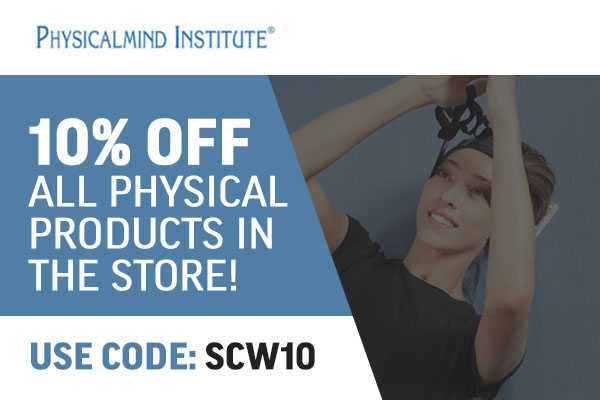 Cortisol should temporarily increase energy production, and then return to base line levels after the stress has ended. The problem is that in our fast paced, very stressful lives, our cortisol levels are chronically elevated. Our bodies are pumping out cortisol almost constantly, which negatively affects other vital functions that cortisol production suppresses.
Cortisol should temporarily increase energy production, and then return to base line levels after the stress has ended. The problem is that in our fast paced, very stressful lives, our cortisol levels are chronically elevated. Our bodies are pumping out cortisol almost constantly, which negatively affects other vital functions that cortisol production suppresses.
HOW DOES CORTISOL WORK
Under stressful conditions, cortisol provides the body with glucose by tapping into protein stores via gluconeogenesis in the liver that results in increased blood sugar levels. Cortisol is also an antagonist to insulin. Insulin is produced by the pancreas to turn this blood sugar into ENERGY. However, since cortisol blocks the effects of insulin, the cells are effectively rendered insulin-resistant.
Consistently high blood glucose levels along with insulin suppression lead to cells that are starved of glucose, regardless of how much food is actually consumed. This means that the cells send more hunger signals to the brain leading to overeating. The unused glucose is eventually stored as body fat, particularly visceral fat where there are four times the number of cortisol receptors in place.
CORTISOL AND INFLAMMATION
Cortisol has positive functions: it wakes us up and also reduces inflammation in the body. However, once again, an excess of cortisol proves to be deleterious. Over time, this effort to reduce inflammation also suppresses the immune system, potentially leading to susceptibility of anything from food allergies to colds. Why? Because cortisol activates the Sympathetic Nervous System (SNS), while the Parasympathetic Nervous System (PNS) is suppressed. Since the two systems cannot operate simultaneously, digestion and absorption are compromised and this leads to the possibility of indigestion and even Irritable Bowel Syndrome (IBS).
CORTISOL OVERLOAD
Clearly, we have to reduce stress/cortisol overload. The most natural method to accomplish this goal is through daily deep, focused breathing. We know this because Dr. Herbert Benson conducted double blind studies at Harvard University in the 60s which proved conclusively that proper breathing could reduce blood pressure and heart rate, and consequently restore homeostasis thereby reducing cortisol.
His technique, performed twice daily for 20 minutes, involves sitting and vocalizing a word, accompanied by deep breathing. Today, however, we sit way too often. Even worse, people sit slumped and compressed with their legs crossed. This typical seated posture actually inhibits what we call three-dimensional breathing.
THE 21ST CENTURY PROTOCOL
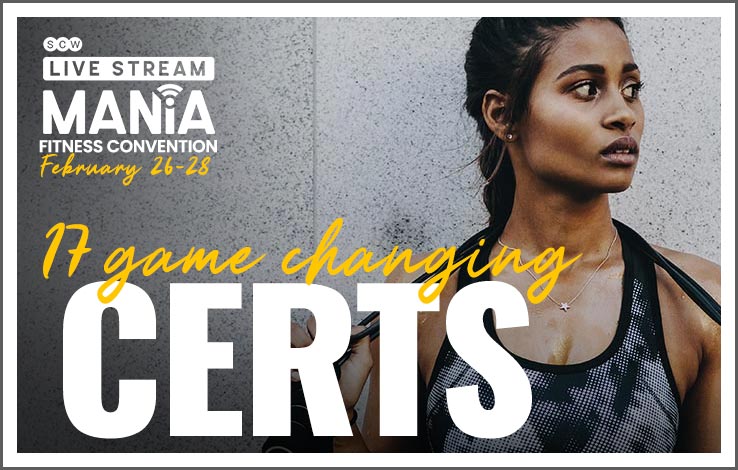 Substituting supine for seated is a better position since it also reduces the impact of gravity. Lying comfortably on the Parasetter® two convex rollers makes the body far more receptive to stress relief because it also reduces tension in the spine. Most importantly, though, we see how deep breathing is facilitated in the supine position. Remember that the lungs are also in the back of the body so focusing the breath into the back ribcage creates a fuller expansion of the thoracic area which improves the diaphragmatic excursion. Plus, Parasetter’s Rib Wrap makes the typically unconscious and shallow act of breathing very physical and tactile. This type of total breathing also increases inner core strength and flexibility and improves circulation.
Substituting supine for seated is a better position since it also reduces the impact of gravity. Lying comfortably on the Parasetter® two convex rollers makes the body far more receptive to stress relief because it also reduces tension in the spine. Most importantly, though, we see how deep breathing is facilitated in the supine position. Remember that the lungs are also in the back of the body so focusing the breath into the back ribcage creates a fuller expansion of the thoracic area which improves the diaphragmatic excursion. Plus, Parasetter’s Rib Wrap makes the typically unconscious and shallow act of breathing very physical and tactile. This type of total breathing also increases inner core strength and flexibility and improves circulation.
OUR COMPLEX SYSTEMS
Parasetter® positively affects three major systems in our bodies: the nervous system, the endocrine system, responsible for cortisol; and the musculoskeletal system.
We know that the musculoskeletal system often develops tension and gets compressed due to daily stresses, whether they be physical or emotional. In order for our fascia and connective tissues to stay flexible and healthy, they need a way to recover from the effects of these stressors. Furthermore, the spine needs to decompress to allow the fascia and peripheral nerves to glide smoothly. When the muscles relax and reset their tone, this will reduce the compression on the peripheral nerves allowing the fascial connections and the nerves to glide easily.
Meanwhile, our AUTONOMIC nervous system functions involuntarily to help us adapt to our changing internal physiological environment. Its goal is the restoration of homeostasis, or internal equilibrium. It does this by synchronizing the dual innervation to the visceral organs, glands and vessels. But constant stresses cause the endocrine system to interfere with this process.
The function of the SNS is to provide optimal conditions for a stress response and mobilizes the body in extreme situations by employing stress response hormones such as cortisol. Meanwhile, the PNS allows us to unwind as it performs maintenance activities and conserves energy. It’s also responsible for digestion and elimination, and keeps blood pressure, heart rate, and respiratory rate at regulated levels. But since the PNS and SNS do not function simultaneously, we need to take control to reduce physical and mental stresses and their resultant imbalances. And this power is within our own reach. Parasetter® and three-dimensional breathing are powerful, natural tools for a longer and healthier life.
If you would like to learn more about PhysicalMind Institute, join them at the upcoming Live Stream MANIA®, February 26-28th. They will be available to chat in the Sponsor Showcase, as well as present educational sessions throughout the weekend.
Share this Post!

Self-Love vs. Self-Care for Fitness Professionals
by Reena Vokoun
As fitness professionals, we are most likely familiar with the importance of practicing self-care in order to enhance or improve our wellbeing. We often encourage our clients to practice it as well. While self-care is extremely important for everyone, it’s critical to understand how it differs from self-love. Ultimately, to be whole, as humans we need both. Fitness professionals especially need both. First, we need to be our best selves, so we can then give back to our clients and others to help them become their best selves.
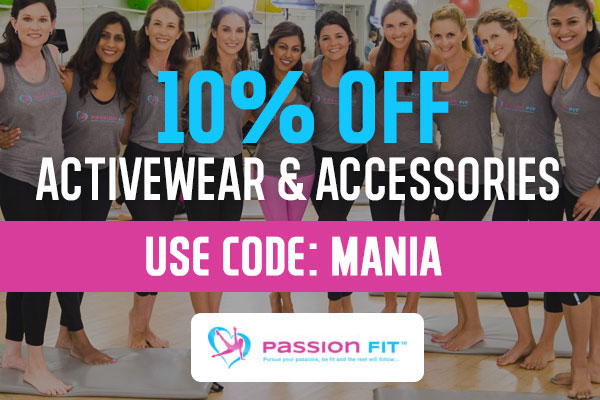 When we practice self-care, we’re likely partaking in activities that improve our personal needs in a timely fashion. That might include actions like exercising, getting a massage, taking a nap, eating healthy, socializing, enjoying a cup of tea or coffee, reading, listening to music and more. These are all really important ways to prioritize our needs, our health and our happiness at a high level. We should absolutely make the time to do these activities on a regular basis, especially if we lead busy lives which involve not only tending to our careers or volunteer work, but also taking care of others.
When we practice self-care, we’re likely partaking in activities that improve our personal needs in a timely fashion. That might include actions like exercising, getting a massage, taking a nap, eating healthy, socializing, enjoying a cup of tea or coffee, reading, listening to music and more. These are all really important ways to prioritize our needs, our health and our happiness at a high level. We should absolutely make the time to do these activities on a regular basis, especially if we lead busy lives which involve not only tending to our careers or volunteer work, but also taking care of others.
However, if we don’t honestly love ourselves unconditionally from the inside out, these accomplishments won’t allow us to fully feel at peace – mentally, emotionally, spiritually and physically. They will simply just be steps that we go through the motions of doing. Self-care, in and of itself, may provide a temporary sense of happiness and wellness in the short term, but we need to have a deep sense of self-love in order to experience true joy, happiness and contentment in our lives in the long term.
Self-love isn’t always easy to obtain and can often be dependent on or influenced by life circumstances, past events, personality traits, family dynamics and other natural tendencies. It may take years to truly feel a sense of self-love, but the more we can prioritize it and practice it, the better. This could come through regular self-reflection, journaling, practicing mindfulness, talking to family and close friends and possibly even through the help of a professional. It can also come from reminding ourselves daily of our positive traits and being empathetic towards ourselves for our negative mannerisms.
 Different life situations can also test our self-love, but staying authentically true to who we are, loving and believing in ourselves, having confidence in our abilities, developing self-respect and not allowing insecurity to take over, are all ways to allow our self-love to still shine through, even in the toughest of situations. Being able to take these actions, despite difficulties in life, can test us and stretch us in ways we may not have ever imagined. Being able to do so and come out on the other side, can allow our self-love to grow within us. The end result could involve becoming resilient, which is a powerful tool, and if mastered, can really help us become strong and capable of dealing with any obstacles we may encounter throughout life.
Different life situations can also test our self-love, but staying authentically true to who we are, loving and believing in ourselves, having confidence in our abilities, developing self-respect and not allowing insecurity to take over, are all ways to allow our self-love to still shine through, even in the toughest of situations. Being able to take these actions, despite difficulties in life, can test us and stretch us in ways we may not have ever imagined. Being able to do so and come out on the other side, can allow our self-love to grow within us. The end result could involve becoming resilient, which is a powerful tool, and if mastered, can really help us become strong and capable of dealing with any obstacles we may encounter throughout life.
Finally, remember we’re all human and we can often be our biggest critics. However, the more we can practice self-love each day and couple it with ongoing self-care as well, the more we can create long-lasting love, happiness, peace, strength and empowerment in our lives. We’ll also be in a position to be wonderful role models for our clients by truly walking the talk ourselves!
If you want to learn more about Passion Fit and what they have to offer, be sure to check them at the upcoming Live Stream MANIA®, February 26-28. Their representatives will have special chat times in the Sponsor Showcase and sessions throughout the weekend.
Share this Post!
 About the Author, Reena Vokoun
About the Author, Reena Vokoun
Reena Vokoun, Founder & CEO of Passion Fit, is an entrepreneur, writer, public speaker, content creator, media spokesperson and certified health & wellness expert through AFAA & ACE. She graduated with a B.B.A. in Marketing & Management from the University of Wisconsin-Madison and an M.S. in Advertising & Communications from Boston University. She spent several years in corporate America working in digital marketing, sales & business development for Google, Yahoo, Reebok, CNET, GE & Grokker.

Pain: The Myths & Facts
by Felix Kade
It sounds absolutely plausible: If a muscle is taken from its optimal position due to poor posture, it has to work more, is overloaded and can possibly cause pain. I have examined whether this assumption is true and if the pain is being caused from that reasoning.
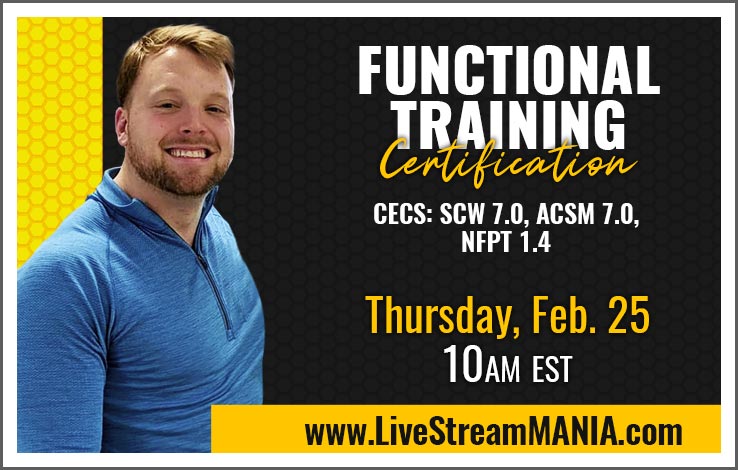 Children are warned to stand in an upright posture for their health and strength. In the book “Stand Up Straight! A History of Posture” Sander Gilman describes where this belief comes from; optimum posture in military organizations, this concept led to working doctors and eventually transferred to the population and became the optimal attitude of the general public. Over the centuries this deep thought has anchored and is located deep in our social consciousness.
Children are warned to stand in an upright posture for their health and strength. In the book “Stand Up Straight! A History of Posture” Sander Gilman describes where this belief comes from; optimum posture in military organizations, this concept led to working doctors and eventually transferred to the population and became the optimal attitude of the general public. Over the centuries this deep thought has anchored and is located deep in our social consciousness.
Today we know that a hollow back leads to pain, round or hanging shoulders triggers complaints, forward head and neck favors crooked pelvis problems and they all possibly lead to UPPER/LOWER CROSS SYNDROME. In the middle of the 20th century, the Czech doctor Vladimir Janda described the upper and lower cross syndrome. Previously the attitude of typical muscular imbalances in the shoulder girdle, causing shoulders to lead, accompanied and led to pain in the neck area. The Lower- Cross Syndrome describes a typical muscular imbalance in the lower body from a hollow back, therefore resulting in back pain. At that time, this idea was revolutionary and spread like wildfire.
Meanwhile, science presents some clear evidence against this theory. For example, there is no connection between the consumer and the stiffness of the muscles (Naseri 2010). We see two separate issues, HOLLOW CROSS AND BACKACHE. If the natural lordosis of the lumbar spine is excessively pronounced, we speak of Hyper-Lordosis or a hollow back, which can lead to these problems. Many coaches try to train their customers from bending the spine into a flat back. According to Janda’s theory, a hollow back is caused by fixed hip flexors, causing weak back and abdominal muscles. Walker et al. already discovered this in 1987. Problems associated with hollow back by training the abdominal muscles cannot be changed. This finding has been repeatedly confirmed (e.g., Levine 1997). Stretching the hip flexors helps untrained and older people, but not as much for active people (Watts et al 2011).
More recent studies even show that a hollow back, although in symptomatic patients can be corrected, not but when asymptomatic. The conclusion is a hollow back is not the cause. In fact, there are at least just as many people with back pain that have a hollow back, as there are people with back pain who don’t have a hollow back (Murrie 2013). 85% of all men and 75% of all women have a hollow back (Herrington 2011) and present no problems.
HEAD POSITION AND NECK PROBLEMS.
Do you think forward head posture is caused by excessive use of smartphones, computers, etc? Interesting, but not necessarily so. A hundred years ago many people occupied this head position. This is another example of how the upper-cross syndrome is possibly explained, but the scientific review is notwithstanding. In 2016, a research team led by Karen Richards examined what similarities people with different postures have in common. Evidence showed that people who are more upright, sitting and standing, or practice sports, have more in common. At the same time, people who suffer from obesity or depression suffered from a rounded posture and a more advanced forward head.
The duration of sitting had no influence on the head position and the distribution of neck pain between the groups is about equal. Also, from other research teams, we know that excessive sitting without an outstretched head posture or with neck problems are also associated (Straker et al. 2008). As you read this, you could get the idea that the consumer does not play a role, but this not true. It is only one of many factors that are important in pain. In order better to understand, need we a modern understanding of pain.
UNDERSTANDING PAIN.
If you jump and land with your foot on a nail between your toes, only piercing the shoe, then no pain has occurred, but the reaction might be that of pain.
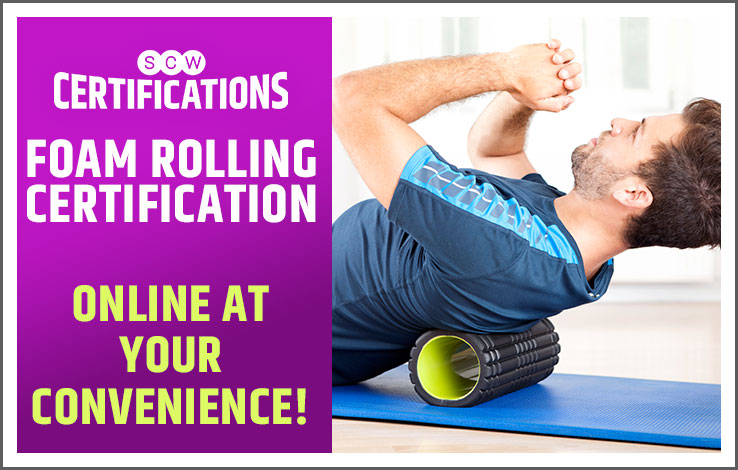 This example was published in the British Medical Journal in 1995. From this study, we learn different things. Very important: there are no pain receptors – otherwise the injured feet would have hurt. That was not the case. He did hurt because the brain – based on the available standing information – giving the response. The man saw the nail in the shoe and from previous experiences with “the nail in the foot” actually felt something is broken. A pain reaction is therefore a meaningful protective response of the system. With the new information, that the nail between the toes can cause the pain response is discovered. The result: Pain is therefore an interpretation of our brain, based on many incredible details. Factors such as injuries, beliefs, inflammation, contextual factors, sensations, depression, stress, lack of sleep, and much more play a role here.
This example was published in the British Medical Journal in 1995. From this study, we learn different things. Very important: there are no pain receptors – otherwise the injured feet would have hurt. That was not the case. He did hurt because the brain – based on the available standing information – giving the response. The man saw the nail in the shoe and from previous experiences with “the nail in the foot” actually felt something is broken. A pain reaction is therefore a meaningful protective response of the system. With the new information, that the nail between the toes can cause the pain response is discovered. The result: Pain is therefore an interpretation of our brain, based on many incredible details. Factors such as injuries, beliefs, inflammation, contextual factors, sensations, depression, stress, lack of sleep, and much more play a role here.
POSTURE AND PAIN
Therapists that work with many pain patients who suffer from shoulder, back, or neck problems and have a “bad” attitude conclude often that the attitude is responsible, although it is now proven that a “bad” attitude rather the consequence of the pain is responsible. As well as depression, stress or obesity. Nevertheless, patients are told the pain came from the entertainment . With this they can unconsciously trigger the so-called placebo effect: The patients will always think that the “wrong” posture is a threat. Accordingly, the brain interprets this information and comes quickly to a pain response. This should therefore stop, but our customers and patients are afraid to do and their attitude changes to something completely normal.
POSITIVE MESSAGES are also helpful. We as living organisms can adapt to diverse loads. Strength training illuminates this. How much can a muscle endure in a certain posture? Our muscles signal us by burning or pain when they get tired. This occurs, for example, if you hold a bottle of water with an outstretched arm for a long time or if you sit the whole day crooked. When you combine a few positions changes the muscles shorten doing nothing and after a few minutes of movement you get to full mobility – (Williams 1990).
CONCLUSION
So different attitudes are not a cause for concern. Rather, attitude is an expression of life and reflects what we often do, think, and feel. Martial artists have rather a flat back, Sprinter rather a hollow back, self-confident people are usually upright, while depressed people are rather slouched. Is it possible to have a sensitive attitude temporarily due to pain? Absolutely! Is the problem caused by posture? Probably not. It is much more important to have varied movements as the perfect entertainment. The positive changed attitude is always the better!
Share this Post!

The COVID Curveball
by Paula Kooperman
As children, many of us fantasize about future careers in the civil and service-oriented sectors; we dream of becoming law enforcement officers, firefighters, doctors, or the many other professions placed front and center in the books we read in school. And even though the protagonists in these childhood stories hold prestigious positions and receive accolades for their bravery, heroism, and service to others, they never quite interested me.
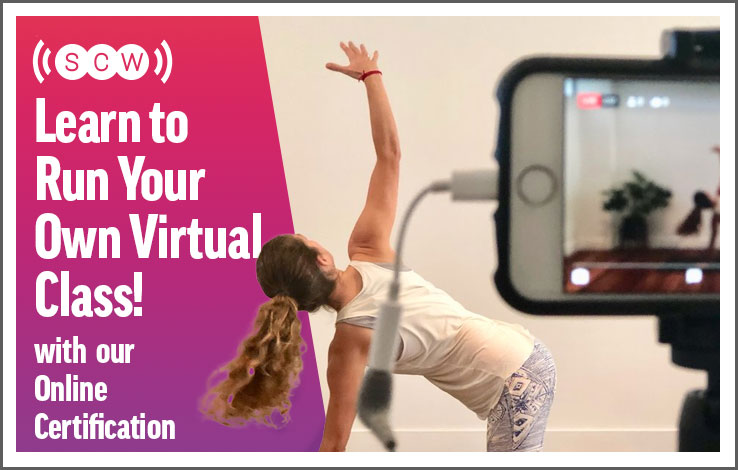 From a young age, I knew that I wanted a career that required movement and activity. I could not fathom working at a job that required me to sit at a desk all day. I was OBSESSED with all things sports; skiing became my first love. In high school, I swam competitively, practiced gymnastics, and joined the pom squad. Being active made me feel better, look better, and kept me both mentally and physically healthy.
From a young age, I knew that I wanted a career that required movement and activity. I could not fathom working at a job that required me to sit at a desk all day. I was OBSESSED with all things sports; skiing became my first love. In high school, I swam competitively, practiced gymnastics, and joined the pom squad. Being active made me feel better, look better, and kept me both mentally and physically healthy.
In college, I pursued a business degree to secure a position within the health and wellness industry. After graduation, I worked in hospital administration and obtained my first fitness instructor certification; I was now a Certified Jazzercise Instructor! My Jazzercise classes at the local fitness center became wildly successful, with participants packing the room to dance their hearts out with me. This success translated to a big promotion, and soon after I was acting Area and District Manager of the club. I was living my dream- getting paid to dance AND getting to wear flashy leotards and legwarmers!
After 25 years, I finally felt like I had achieved both personal and professional success. I had significantly expanded my professional resume; I began attending SCW’s MANIA® Conventions for continuing education and added multiple certifications to my fitness professional toolbox. I was happily married and had four grandchildren to love and spoil rotten.
Then, life threw me a curveball. I’m talking about the kind of curveball the greatest major league pitchers or all-time would envy: COVID-19.
I was unprepared. Constant lockdowns. Furloughed from my job. Quarantining for what felt like an eternity. What do I do now? A question that played on repeat like a broken record in my mind. As I turned to Facebook for some much-needed socialization, the idea hit me like a ton of bricks: teach fitness classes online!
If you’re like me, understanding social media is about as easy as teaching your dog nuclear physics. But I knew I had to try. I NEEDED to move. I NEEDED to connect. And most importantly, I NEEDED community.
In March of 2020, I began using Facebook’s platform to teach virtual group fitness classes. Slowly, I became Facebook savvy and my virtual attendee numbers began to grow. By June, I averaged 100 attendees for each class. And the outpouring of love and positive feedback I received from my Facebook community assured me that I was helping to provide the sense of community that so many of us desperately needed.
And then came curveball number two.
 My club (yes, the club that furloughed me earlier in the year) gave me an ultimatum: continue to teach virtual fitness classes or maintain my leadership position.
My club (yes, the club that furloughed me earlier in the year) gave me an ultimatum: continue to teach virtual fitness classes or maintain my leadership position.
I knew I could not leave the online community I had worked so hard to build. But I couldn’t lose my source of income, either. That’s when I decided to turn the community I had built into a real business.
PSK4Life.com, the virtual, subscription-based fitness platform I built from the inspiration of my Facebook community, launched in August 2020. We offer 10-12 live classes each week and have a library with over 400 fitness class for streaming at any time. Offering both annual ($300) and monthly ($30) subscription options, we built a community of over 260 subscribers in our first month.
Looking back, I can now say that I am thankful for those curveballs. I may not have hit them just out of the park yet, but I am proud. Proud of my community. Proud of the many fitness professionals in the industry thriving despite being thrown their own curveballs. And proud of myself.
Do I miss club life? Absolutely. But I choose not to focus on what I may have lost, but instead on what I have GAINED: a community and a renewed sense of pride.
When life throws you a curveball, step up to the plate! You might strikeout. You might hit a homerun. But you’ll never know what you’re capable of sitting in the dugout.
A note from Sara Kooperman, JD, CEO of SCW Fitness Education and WATERinMOTION®
“We’re in this together”: the phrase heard during 2020 as the global pandemic wrapped its hand around the fitness industry and fully engulfed it in its fist. But the together aspect was hard to reconcile. We faced facility closures, the cancellation of the industry’s biggest events, and the government labeling us as “non-essential.” Yet we marched forward. We proved just how essential we are. We reached clients through phone and laptop screens. We created unique ways and platforms for our community to educate, empower one another, and thrive.
When I heard Paula Kooperman’s story, it reminded me of the resilience of fitness professionals and the entire industry as a whole. Stories such as Paula’s help to infuse meaning and inspiration into events that can otherwise feel hopeless and cruel. These stories remind us that others have survived and amid loss and desperation, we, too, can find inspiration and resolve.
Though Paula and I share no familial DNA, only sharing relation by marriage, our love of fitness is innate and genetic. It resonates with all of us in this industry. I am continually inspired by the hard work, continued optimism and creativity exemplified by fitness professionals during these uncertain times. Words cannot describe how truly grateful I am to be part of this larger, amazing “family”!
Share this Post!

Recipe: Blueberry Roll Ups
by The Blueberry Council
Since February is Happy American Heart Month, then a burst of blue is the perfect way to help take care of your heart. Blueberries can help to improve cardiovascular health, according to a recent research study published in the American Journal of Clinical Nutrition. The study revealed that when adults with metabolic syndrome (factors that raise a person’s risk for heart disease and other health problems) ate one cup of fresh blueberries everyday there were significant improvements in heart health.
 To read these findings and more information on blueberries, visit the U.S. Highbush Blueberry Council website here. Enjoy your blueberries, your heart will thank you.
To read these findings and more information on blueberries, visit the U.S. Highbush Blueberry Council website here. Enjoy your blueberries, your heart will thank you.
Ingredients:
- ½ cup coconut flavored yogurt (can substitute vanilla yogurt)
- 4 multi-grain tortilla wraps (10-inch)
- ½ cup unsweetened shredded coconut
- 2 cups blueberries (use frozen, thawed and rinsed, if fresh not available)
- 1 cup granola
Instructions:
- Spread yogurt down along the center of each tortilla, leaving a small border on both ends.
- Sprinkle with shredded coconut.
- Top with blueberries and granola.
- Fold up the bottom of tortilla over the filling, then fold in sides and roll up like a burrito.
Share this Post!

We’re always looking for great content highlighting the newest things in the world of fitness. Please submit your article directly to editor@scwfit.com for immediate consideration!
Give us your feedback on what interests you, and maybe YOU will make it in the SCW Spotlite!
Share Your Thoughts >>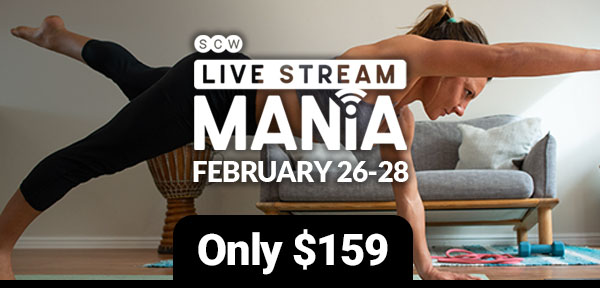
Live Stream MANIA®
February 26-28
Register Here
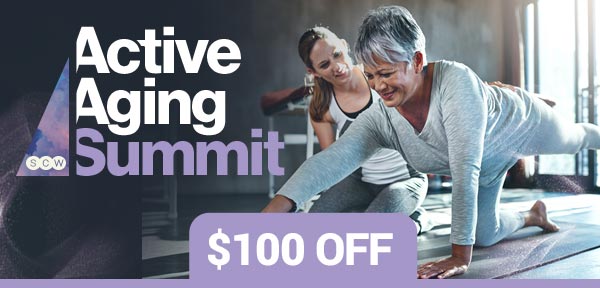
Active Aging Summit
March 20-21
Learn More Here

MANIA NOW $100 OFF
Get MANIA NOW
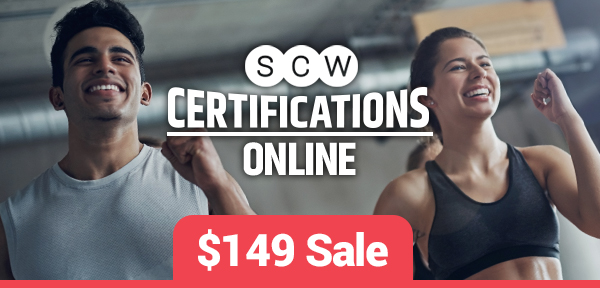
SCW Online Certifications
$110 OFF
Choose Your Cert Here
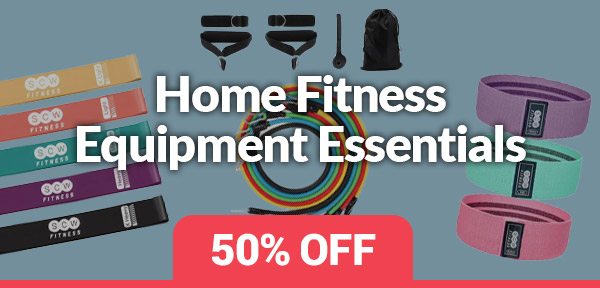
50% OFF Home Equipment Must-Haves
Shop the 50% Sale Here
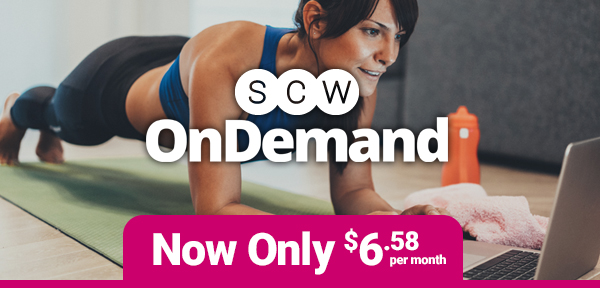
Save $20
SCW OnDemand
Video Subscription
Subscribe & Use Code: ONDEMAND20
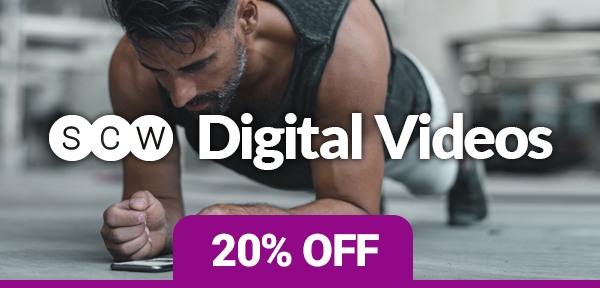
20% OFF SCW Digital Videos
Choose Videos & Use Code: VIDEO20
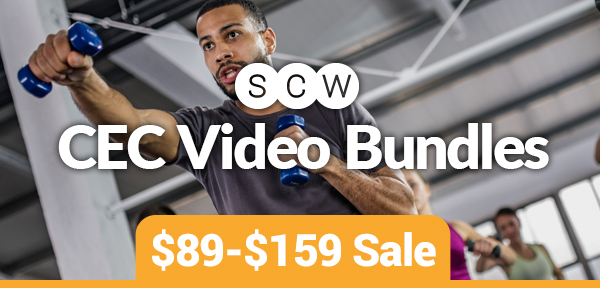
$50 OFF 20 CEC Video Course Bundles
(Was $139, Now $89) or (Was $209, Now $159)
Choose Bundle & Use Code: VIRTUAL50

FREE Upcoming Webinars From SCW
Register FREE Here

